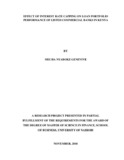| dc.description.abstract | This study sought to determine the effects of interest rates capping on the increase of
value of the loan book, customer deposits, firm size and non-performing loans of
commercial banks was significant one across the industry. This study was necessitated
by the law passed in August 2016 that came into effect in September 2016 seeking to
regulate and place a cap on interest rates charged by commercial banks in Kenya. The
argument by commercial banks in Kenya was that this law would have had negative
repercussions, and that there would likely be cases of credit rationing in the economy,
and commercial banks would end up suffering. This study adopted a study research
design and data collection was both quantitative in nature, from banks’ financial
statements .The population targeted was all listed commercial banks at Nairobi
Securities Exchange. Quarterly data was collected and analysed for a period of 12
quarters, with 6 quarters period prior (31st March 2015 to 30th June 2016) and 6 quarter
after (31st Dec 2016 to 31st March 2018). Data was obtained from the Central bank of
Kenya, where quarterly report of the banking sector in Kenya is usually carried out.
The event study on the dependent variables was analyzed in terms of Paired T-test
analysis both periods of the study. Natural log of all the variables was used for
efficiency of data analysis in SPSS. This study conducted paired samples test to find
out whether the increase of value of the loan book, customer deposits, firm size and
non-performing loans of commercial banks was significant one across the industry. The
results of this study revealed that interest rates and levels of personal loans advanced
by commercial banks are related. The results indicated that there was a significant
change and movement in the levels of personal loans for the two periods, and that after
the interest rates capping at 14%, the levels of personal loans advanced by commercial
banks increased significantly. This leads to the conclusion that at low interest rates,
demand for personal loans increases, and that at higher rates of interest, demand for
personal loans goes down. Having concluded that there was significant change on the
increase of value of the loan book, customer deposits and firm size the study
recommends that commercial banks should adopt effective lending practices that will
enable reduction of non-performing loans which have increased after capping of interest
rates. | en_US |



